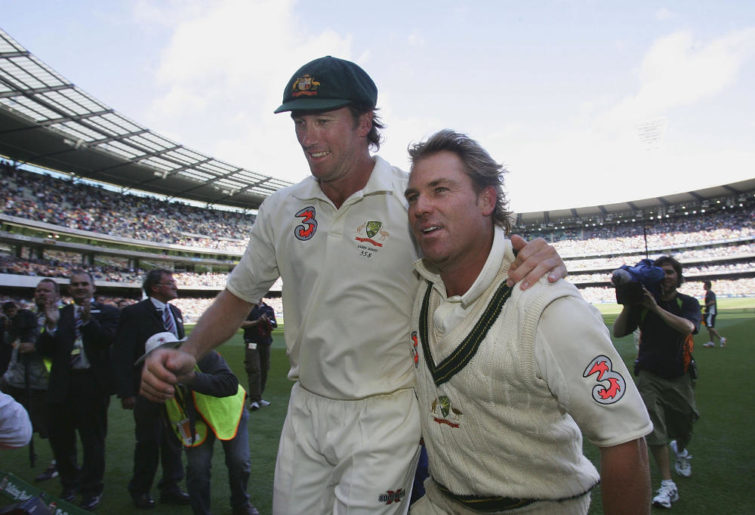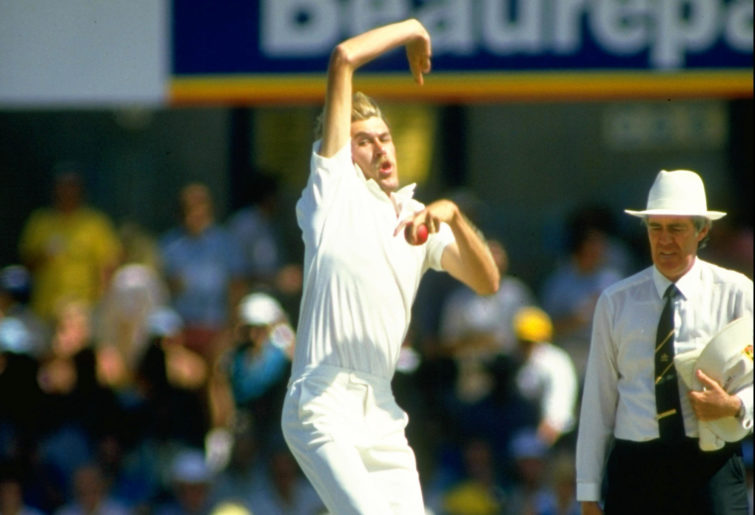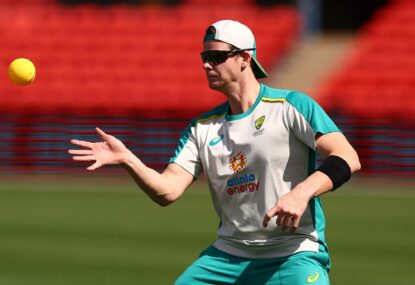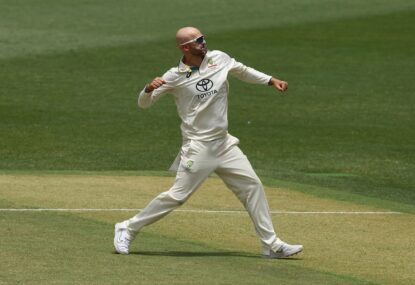After reviewing our great spinners, let’s now turn to the pace bowlers.
In splitting these articles up, I’ve identified first a selection of bowlers who are considered the attack leaders of their time to see how their performances in wins compare. Remember that the Peer Difference Percentage I mention measures how the bowler performed compared to his teammates in the same matches.
Glenn McGrath
84 wins (67.7 per cent of all matches), 20 losses and 20 draws. Wins average 19.19 (peer difference: +20.8 per cent). Wins wickets per match 4.93.
Glenn McGrath won more matches than any other bowler, other than his long time teammate Shane Warne. In those victories, McGrath’s bowling average of 19.19 ranks tenth on Australia’s all-time list (minimum ten wins). This was achieved by consistency: McGrath’s economy rate and strike rate were both very good, although neither on its own is all-time top ten.
McGrath’s bowling average in wins is nearly 21 per cent better than his peers on those matches. His economy rate is nearly 15 per cent better than his peers, which sounds very good. It is actually exceptional, being the third-best Peer Difference Percentage in history behind only Hugh Trumble and Bill O’Reilly.
Therefore, McGrath is possibly the most economical pace bowler of all time. To do this while having a strike rate just over 7 per cent better than his fellow bowlers is simply excellent.
McGrath’s legendary consistency means his performances in losses is, if anything, better than in wins. His bowling average in losses is 23.89 per cent, which is the fourth-best all-time. McGrath is not considered an out-and-out strike bowler, but his strike rate in losses is bettered by only 1970s Establishment lone star Rodney Hogg and current super strike bowler Mitchell Starc.
McGrath took 4.35 wickets per Test in losses, bettered only by 19th Century bowler Charles ‘Terror’ Turner, legendary leg-spinner Clarrie Grimmett, and surprisingly the lion-hearted Merv Hughes. McGrath’s comparison to peers in losses makes great reading. His economy rate Peer Difference Percentage is the best of all time and his bowling average Peer Difference Percentage ranks second.
McGrath is likely Australia’s best-ever pace bowler in lost causes.
McGrath was also around five per cent better than his peers in draws and his strike rate is ninth all-time.
The two players on either side of McGrath for bowling average in wins are both exceptional and will be examined below: Ray Lindwall and Graham McKenzie.

Glenn McGrath (L) and Shane Warne of Australia leave the ground together in their final match at the MCG on December 28, 2006 in Melbourne, Australia. (Hamish Blair/Getty Images)
Dennis Lillee
31 wins (44.3 per cent of all matches), 16 losses and 23 draws. Wins average 18.27 (peer difference: +24.8 per cent). Wins wickets per match 6.55.
Dennis Lille is typically in the thick of any discussion regarding the greatest pace bowlers. His bowling average in wins supports this. It is sixth all-time and if we look just at fast bowlers, only 1960s great left-arm bowler Alan Davidson is ahead of him.
This was achieved by an unparalleled strike rate in wins of just 39. With a minimum ten wins, only the 19th-century all-rounder George Giffen is better and no one else breaks 40. 6.55 wickets per Test is second only to Clarrie Grimmett. In only 31 wins Lillee took ten wickets in a match six times.
Only Warne has more ten-fors and he took nearly triple the number of wins to achieve it. Lillee’s Peer Difference Percentages are excellent and in terms of strike rate only Graham ‘Garth’ McKenzie is better in comparison to peers than Lillee’s 27.9 per cent.
In other words, while McGrath may be the greatest in losses, Lillee is almost certainly the greatest in wins. Given you have to take 20 wickets to win, a wickets per Test number that is historically unmatched for pace bowlers is maybe the most telling point.
In losses Lillee averaged over 29, nearly six points behind McGrath. This is still good enough to be sixth of all time and nearly 10.5 per cent better than his fellow bowlers in those defeats. In draws he was still nearly 9.5 per cent better than his peers and his average, strike rate and wickets per Test in draws are all in the all-time top ten (ninth, eighth and third respectively).
So Lillee was almost as good whether in a win, loss or draw.
The player with a winning average closest to Dennis Lille is leg-spin and commentary icon Richie Benaud.

Dennis Lillee (left) and Jeff Thomson. (PA Images via Getty Images)
Ray Lindwall
33 wins (54.1 per cent of all matches), nine losses and 19 draws. Wins average 19.13 (peer difference: +11.4 per cent). Wins wickets per match 4.18.
The McGrath versus Lillee discussion tends to overshadow this great post-war bowler, Ray Lindwall. His bowling average in wins is almost identical to McGrath and his percentage of matches won exceeds Lillee. However, Lindwall’s Peer Comparison Difference of 11.4 per cent is well behind both McGrath and Lillee.
This is for different reasons. When comparing to their peers Lindwall has a similar economy rate performance to Lillee but a higher strike rate. When comparing to McGrath, it’s the exact opposite: Better strike rate in comparison to peers, but worse economy rate. But these are still very good numbers for Lindwall.
In losses Lindwall performed just over three per cent worse than his peers in those matches, mainly due to a high strike rate.
However, in draws, Lindwall was truly excellent. His average of 27.84 is third all-time behind only Jeff Thomson and Bruce Reid and is 21.8 per cent better than his fellow bowlers in those matches.
Alan Davidson
16 wins (37.2 per cent of all matches), eight losses and 19 draws. Wins average 16.04 (peer difference: +26.8 per cent). Wins wickets per match 5.56.
Alan Davidson is often considered our greatest ever left-arm bowler. On the numbers above he is in the conversation for greatest ever, left or right arm. Davidson’s average in wins and Peer Difference Percentage is better than either McGrath or Lillee.
Only legendary leg spinner Bill O’Reilly has a better average in wins (minimum ten wins). In wickets per Test Davidson ranks sixth all-time. In terms of difference to his peers in wins, only Graham McKenzie is better than Davidson’s 26.8 per cent. Davidson does not feature in the best strike rates, but his economy rate of 1.86 is simply outstanding.
This last point is maybe why Davidson is not always mentioned in the same breath as the other great bowlers above. His winning percentage is lower, with a lot of draws as the era was dominated by low scoring rates and safety-first cricket.
Was Davidson good in losses? My word he was! Davidson’s bowling average in losses of 17.13 is the second-best in history (minimum five losses), behind only 19th-century bowler JJ Ferris. Davidson was 52.7 per cent better than his fellow bowlers in losses.
Davidson played in a lot of draws and performed creditably, being around 1.85 per cent better than his peers. His bowling average of 31.32 is fifth of all-time. Davidson’s strike rate in draws was not too impressive at nearly 94, but he continued to keep things tight, being seven per cent better than his peers at only two runs per over.
All of this points to an underrated bowler, more McGrath than Lillee, but easily in the conversation with both of them.

Alan Davidson. (Central Press/Getty Images)
Graham ‘Garth’ McKenzie
18 wins (30.0 per cent of all matches), 17 losses and 25 draws. Wins average 19.19 (peer difference: +27.54 per cent). Wins wickets per match 6.22.
Speaking of underrated. Garth McKenzie’s raw numbers don’t tend to put him in the conversation with these other great bowlers, but if we unpack it a bit he comes up rather well. McKenzie’s average in wins is 11th all-time.
But that only tells a small part of the story. As the lone attack leader of some pretty weak bowling attacks, this average was a whopping 27.5 per cent better than his peers. This the best result in terms of comparison with his peers in Australian history (minimum ten wins). Then if we look at wickets per test, McKenzie is one of the select few to take over six wickets per test.
Only bonafide greats Clarrie Grimmett, Bill O’Reilly and Dennis Lillee took more. This points to a player who dragged his side to victories. In his 18 wins, McKenzie took five wickets in an innings nine times and took three ten-wicket match hauls. The only downside is that McKenzie only won 30 per cent of his Tests.
McKenzie holds up well in draws, his average of 31.7 is sixth all-time (minimum ten draws). Again he was often out on his own and his wickets per Test of 3.96 is fourth-best all-time. His peer comparison for bowling average is again elite at nearly 28 per cent better than his fellow bowlers. His average in draws is better than either Lillee or McGrath.
So why is McKenzie not often mentioned in greatest-ever discussions? Maybe his performance in losses gives us a clue. When McKenzie went down, his team went down. And when McKenzie struggled, he really struggled. In losses his stats read: bowling average 57.31 and strike rate 128.7.
He took just two wickets per Test and his average is a dreadful 60 per cent worse than his peers in those matches. McKenzie bowling average in losses is the worst for any Australian bowler with a minimum of even five losses (with the added qualifier of at least two wickets per Test to remove part-timers).
These performances in losses drag McKenzie’s overall figures out of the elite category.
Let’s finish with two other ‘attack leaders’ who didn’t quite make the ten-win qualification.
Fred Spofforth
Six wins (33.3 per cent of all matches), nine losses and three draws. Wins average 13.11 (peer difference: +28.3 per cent). Wins wickets per match 8.50.
‘The Demon’ Fred Spofforth was one of our first legendary bowlers, taking 14 wickets to almost single-handedly win the famous match at The Oval in 1882 that created The Ashes. Spofforth’s average in wins is second only to 1930’s spinner Bert Ironmonger (minimum five wins) and his 8.5 wickets per Test is unmatched in Australian history.
Only three other bowlers in the world have ever done better. Spofforth had a strike rate in wins of only 30.4. This is also the country’s best ever and was 60 per cent better than his peers.
He was nearly as good in losses, with an average that is fifth all-time, nearly 17 per cent better than his peers. Only one other bowler played in as many as his nine losses with a better average, fellow old-timer Charles ‘Terror’ Turner. Spofforth only played in three draws and his average was an unremarkable 35.22.
Bruce Reid
Five wins (19.2 per cent of all matches), five losses and 16 draws. Wins average 14.51 (peer difference: +43.9 per cent). Wins wickets per match 7.8.

Bruce Reid was Australia’s top bowler before the ’87 World Cup. (Adrian Murrell/Allsport)
Oh, what might have been. Bruce Reid’s career was blighted by injury but his record in wins is amazing. An average in wins of 14.51 is fifth all-time (minimum five wins) and he was 43.9 per cent better than his peers in those matches. This peer comparison is the best of all-time (minimum five wins).
Reid’s strike rate of 36.9 is the fourth-best of all time and his 7.8 wickets per match is second only to Fred Spofforth. These are truly remarkable numbers, but of course, they are only across five matches.
In losses Reid maintained decent standards, his bowling average of 33.5 was over 12 per cent better than his peers. However in draws Reid was extremely effective.
For those who played in at least ten draws only Jeff Thomson had a better bowling average and strike rate. Once again, his difference to his peers of 45.34 is the best of all-time (with a minimum of even five draws).
A longer career may have had Reid being analysed first in this article.
Next time we look at the extreme speed merchants and see whether having an express bowler in the arsenal is vital to winning.








































































































